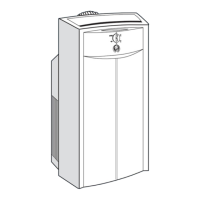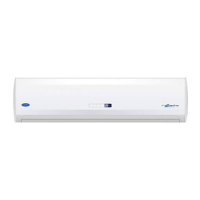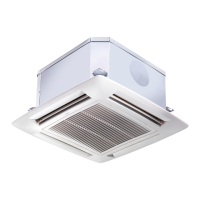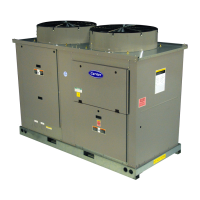T -295
4-10
e. Remove capscrews and lift off power head and cage
assemblies and gaskets.
f. Check, clean and remove any foreign material from
the valve body, valve seat and mating surfaces. If re-
quired, replace valve body.
NOTE
Do not adjust the new replacement expansion
valve. Valves are preset at the factory.
g. Using new gaskets, install new cage and power head
assemblies.
h. Leakcheckthenewvalveandevacuateanddehydrate
low side. (Refer to paragraph 4.7.)
i. The thermal bulb i s installed below the center of the
suctionline(fouroreight o’clockposition). This area
must be clean to ensure positive bulb contact. Strap
thermal bulb to suction line. Ensure that retaining
straps are tight and renew insulation.
j. Fasten equalizer line to the expansion valve.
k. Open filter-drier inlet service valve and compressor
service valves.
l. Run the coach for approximately 30 minutes on fast
idle.
m.Check refrigerant level. (Refer to paragraph 4.8.1)
n. Check superheat. (Refer to paragraph 4.19.2.)
4.19.2 Superheat Measurement
NOTE
All readings must be taken from the TXV bulb
location and out of the direct air stream.
1
2
3
4
5
1. Suction Line
(section view)
2. TXV Bulb Clamp
3. Nut & Bolt (clamp)
4. Thermocouple
5. TXV Bulb (Shown
in the 4’clock
position)
Figure 4-14.Thermostatic Expansion Valve Bulb
and Thermocouple
a. Open top cover. Refer to paragraph 4.2.
b. Remove Presstite insulation from expansion valve
bulb and suction line.
c. Loosen one TXV bulb clamp and make sure area un-
der clamp is clean.
d. Place temperature thermocouple in contact with the
suction tube and parallel to the TXV bulb, and t hen
secure loosened clamp making sure both bulb and
thermocouple are firmly secured to suction line.
(SeeFigure 4-14.) Reinstall insulation around the
bulb.
e. Connect an accurate low pressure gauge to the low
pressure port (9, Figure 1-6)
f. Cl ose top cover being careful to route t hermocouple
sensing wire and gauge hose outside the unit.
g. Start bus and run on fast idle until unit has stabilized,
about 20 to 30 minutes.
NOTE
When conducting this test, the suctionpressure
must be at least 6 psig (0.41 bar) below the ex-
pansion valve maximum operating pressure
(MOP). Refer to paragraph 1.3 for MOP.
h. From the temperature/pressure chart (Table 4-4), de-
termine the saturation temperature corresponding to
the evaporator outlet pressure.
i. Note the temperature of the suction gas at the expan-
sion valve bulb. S ubtract the saturation temperature
fromthis temperature.Thedifferenceis thesuperheat
of the suction gas.
j. The superheat may cycle from a low to high reading.
Monitor the superheat taking readings every 3--5
minutes for a total of 5--6 readings. Calculate the su-
perheats, add the readings and divide by the number
of readings taken to determine average superheat.
The superheat should be 10Fto12F.
k. Ifsuperheatis not within tolerance, replace thevalve.
4.20 COMPRESSOR MAINTENANCE
4.20.1 Removing the Compressor
If compressor is inoperative and the unit still has
refrigerant pressure, isolate the compressor and remove
the refrigerant. Refer to paragraph 4.5.2. If compressor
is operative, perform a pump down. Refer to paragraph
4.5.3.
a. Placemainbatterydisconnect switchin OFFposition
and lock.
b. Loosen bolts at suction and discharge service valve
flanges and break seal to be sure pressure is released.
remove bolts.
c. Tag and disconnect wiring to the high pressure and
low pressure switch, unloaders and clutch.
d. Remove four bolts holding compressor to base
e. Attachsling orotherdeviceto the compressor and re-
movecompressor from thecoach throughthe rearac-
cess door.

